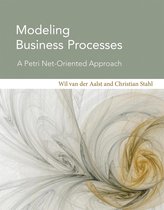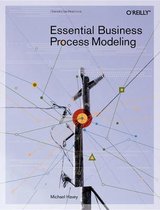A Pragmatic Guide To Business Process Modelling
Afbeeldingen
Artikel vergelijken
Samenvatting
Process modelling is an essential part of understanding the complexities and communication issues inherent in any business. However, this process modelling is often naive and overly simplified, leading to inaccurate, inefficient or entirely inappropriate process definitions. Many process modelling approaches consist of a single flow-chart style view that provides a basic representation of logical order and the input and output of each process, but this is, in most cases wholly inadequate. Consider the analogy of a magician performing a card trick - the process is easy to follow but impossible to replicate from the audience's point of view. To replicate such a magic trick it is necessary to understand several different views of the trick, rather than simply looking at it from the audience's point of view. A full understanding will require some degree of domain knowledge concerning magic and sleight-of-hand, and insight into the hidden complexities behind the trick and a knowledge of the mis-communication devices employed by magicians. The challenge, therefore, is in creating an accurate and concise model of a process - a task that is plagued with complexity and difficulty in understanding the often-buried processes and communication trails that exist. Despite the dynamic behaviour of organizations, they can be thought of as operating or behaving as a number of interrelated processes. Purchasing Process Modelling software is often perceived as the starting point to defining business processes, but unless this is underpinned with a solid and complete understanding of how each process works, results will always be inefficient. A Pragmatic Guide to Business Process Modelling provides practical advice on how to model business processes effectively, drawn from the author's vast consulting experience. To truly understand how an organization functions, just considering information flow is never enough. The stakeholders involved in the process must be considered, along with the information produced (and the relationships between this information) all of which depends upon a clear understanding of the terminology being employed. Of course, no amount of process modelling will help if the basic reason why the processes is needed - the requirements - are not fully understood. Process modelling must also apply to procedures, standards, work instructions, guidelines as well as the business processes themselves. In turn each of these needs to be analysed, mapped, measured and documented to gain an understanding of the organization in its totality. A Pragmatic Guide to Business Process Modelling helps you specify, visualize, and document your business processes, so that you can analyse your future requirements and design solutions that meet them. Jon Holt's approach to business process modelling provides insight and clarity for business people, whilst providing information sufficiently detailed to develop the requirements of any kind of computer information system. A Pragmatic Guide to Business Process Modelling : covers all aspects of process modelling from process analysis to process documentation; includes examples of processes: standards, work instructions, guidelines and general business procedures; features practical examples and detailed case studies from a variety of industries; and provides practical guidance for directors and managers on business process modelling to improve processes, productivity and profitability. A Pragmatic Guide to Business Process Modelling applies visual modelling techniques to process modelling, using the Unified Modelling Language (UML), an ISO standard which is used increasingly by businesses globally. Although many people are using UML for process modelling, most organizations only use a single diagram - namely the activity diagram which shows a flowchart-style view of processes: the input through to output. The techniques in A Pragmatic Guide to Business Process Modelling show how to realise far more benefits, by also using other diagrams to give different views of the business, from high level overviews, to the seeing the system form a single user's perspective. Process Modelling has become a core competency for anyone involved in managing or influencing change; whether improving communications, reducing an organization's complexity, managing risk or supporting good corporate governance. But, to model effectively, you need Jon Holt's A Pragmatic Guide to Business Process Modelling .
Productspecificaties
Wij vonden geen specificaties voor jouw zoekopdracht '{SEARCH}'.
Inhoud
- Taal
- en
- Bindwijze
- Paperback
- Aantal pagina's
- 160
- Illustraties
- Nee
Betrokkenen
- Hoofdauteur
- Jon Holt
- Hoofduitgeverij
- British Computer Society
Overige kenmerken
- Editie
- New title
- Verpakking breedte
- 172 mm
- Verpakking hoogte
- 10 mm
- Verpakking lengte
- 246 mm
- Verpakkingsgewicht
- 394 g
EAN
- EAN
- 9781902505664
Je vindt dit artikel in
- Taal
- Engels
- Boek, ebook of luisterboek?
- Boek
- Beschikbaarheid
- Leverbaar
- Studieboek of algemeen
- Algemene boeken
Kies gewenste uitvoering
Kies je bindwijze
(2)
Prijsinformatie en bestellen
De prijs van dit product is 26 euro en 80 cent. Dit is een tweedehands product.Alleen tweedehands
Goed
1 - 2 weken
Verkoop door
Bogamo 12 - Boeken outlet
- Bestellen en betalen via bol
- Prijs inclusief verzendkosten, verstuurd door Bogamo 12 - Boeken outlet
- 30 dagen bedenktijd en gratis retourneren
Shop dit artikel
Rapporteer dit artikel
Je wilt melding doen van illegale inhoud over dit artikel:
- Ik wil melding doen als klant
- Ik wil melding doen als autoriteit of trusted flagger
- Ik wil melding doen als partner
- Ik wil melding doen als merkhouder
Geen klant, autoriteit, trusted flagger, merkhouder of partner? Gebruik dan onderstaande link om melding te doen.









